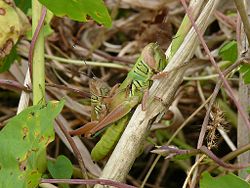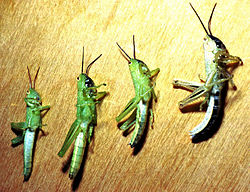Hieroglyphus daganensis
 From Wikipedia - Reading time: 5 min
From Wikipedia - Reading time: 5 min
| Hieroglyphus daganensis | |
|---|---|

| |
| H. daganensis male & female | |
| Scientific classification | |
| Kingdom: | Animalia |
| Phylum: | Arthropoda |
| Class: | Insecta |
| Order: | Orthoptera |
| Suborder: | Caelifera |
| Family: | Acrididae |
| Subfamily: | Hemiacridinae |
| Genus: | Hieroglyphus |
| Species: | H. daganensis
|
| Binomial name | |
| Hieroglyphus daganensis Krauss, 1877
| |
| Synonyms | |
|
H. abbreviata Krauss, 1877 | |
The African rice grasshopper, Hieroglyphus daganensis[1][2] is a medium-sized grasshopper species found in the Sahel region. Although not called a locust in English, this species shows gregarious behaviour and some morphological change (phase polymorphism) on crowding[3] and may become a moderately important pest species for small-holder farmers in the region.[4][5][6][7][8][9][10][11][12][13][14][15]
Description and biology
[edit]Adults
[edit]The overall colour of adult insects is usually green, with a finely dotted shiny integument. Antennae are longer than the head and pronotum together. The pronotum is cylindrical, with three deep and wide sulci (grooves) crossing the dorsum.
Hoppers
[edit]
The colour of immature insects may vary depending on their phase (illustrated right) during a particularly fertile year, dense populations of H. daganensis showed a distinct blackening in certain areas of cuticle.
Outbreaks and control
[edit]Outbreaks are frequent in Sahelian countries such as Senegal, Mauritania, Burkina Faso, Mali, Niger and Benin. It has also been recorded as a sorghum pest in India.[16]
A biological pesticide product called 'Green Muscle' is based on the entomopathogenic fungus (Metarhizium acridum) is now available (see desert locust). Early demonstrations of efficacy took place in northern Benin, with field tests by the LUBILOSA Programme on H. daganensis.
Human consumption
[edit]The Northern Dogon people of Mopti Region, Mali consume the species.[17]
References
[edit]- ^ Krauss (1877) Orthoptera von Senegal, gesammelt von Dr. Franz Steindachner, Sitzungsberichte der Österreichischen Akademie der Wissenschaften. Mathematisch-Naturwissenschaftliche Klasse (Abt. 1) (Sitz. öst. Akad. Wiss. Math-naturw. Kl. Abt. 1) 76(1):29-38
- ^ Roskov Y.; Kunze T.; Orrell T.; Abucay L.; Paglinawan L.; Culham A.; Bailly N.; Kirk P.; Bourgoin T.; Baillargeon G.; Decock W.; De Wever A. (2011). Didžiulis V. (ed.). "Species 2000 & ITIS Catalogue of Life: 2011 Annual Checklist". Species 2000: Reading, UK. Retrieved 24 September 2012.
- ^ Uvarov, B.P. (1966). "Phase polymorphism". Grasshoppers and Locusts. Vol. 1. Cambridge University Press.
- ^ COPR (Centre for Overseas Pest Research) (1982), The Locust and Grasshopper Agricultural Manual
- ^ Johnston, H.B. (1968), Annotated catalogue of African grasshoppers, The Cambridge University Press, Cambridge Suppl:448 pp.
- ^ Johnston, H.B. (1956), Annotated catalogue of African grasshoppers, The Cambridge University Press, Cambridge 833 pp.
- ^ Dirsh (1965), The African Genera of Acridoidea, Cambridge University Press, Antilocust Centre, London 579 pp.
- ^ Mestre & Chiffaud (2006), Catalogue et atlas des acridiens d'Afrique de l'Ouest
- ^ Descamps (1965) Acridoides du Mali (Deuxieme contribution). Regions de San et Sikasso (Zone soudanaise) (1 partie) et (2 partie), Bulletin de l'Institut Fondamental d'Afrique Noire (IFAN). Série A: Sciences Naturelles (Bull. IFAN (A)) 27:922-962, 1259-1314
- ^ Davey, Descamps & Demange (1959) Notes on the Acrididae of the French Sudan with special reference to the central Niger delta (I, II), Bulletin de l'Institut Fondamental d'Afrique Noire (IFAN). Série A: Sciences Naturelles (Bull. IFAN (A)) 21(1-2):60-112, 565-600
- ^ Descamps (1956) Insectes nuisibles au riz dans le Nord Cameroun, AgronomieTropicale (Nogent-sur-Marne) (Agron. Trop. (Nogent-sur-Marne)) 11:732-755
- ^ Kevan, D.K.M. (1956) Results from the Danish Expedition to the French Cameroons 1949-50: XV. Orthoptera: Acrididae, Bulletin de l'Institut Fondamental d'Afrique Noire (IFAN). Série A: Sciences Naturelles (Bull. IFAN (A)) 18(3):960-977
- ^ Popov, G.B. (1959) Some notes on injurious Acrididae (Orthoptera) in the Sudan-Chad area, Entomologist's Monthly Magazine, London (Ent. Monthly Mag.) 95:90-92
- ^ Mason, J.B. (1973) A revision of the genera Hieroglyphus Krauss, Parahieroglyphus Carl and Hieroglyphodes Uvarov (Orthoptera: Acridoidea), Bulletin of the British Museum (Natural History) Entomology (Bull. Br. Mus. (Nat. Hist.) Ent.) 28(7):507-560
- ^ Southcott (1994) A new larval erythraeine mite (Acari: Erythraeidae) from West Africa, International Journal of Acarology (Int. J. Acarology) 20(2):81-85
- ^ Kalaisekar, A (2017). Insect pests of millets: systematics, bionomics, and management. London: Elsevier. ISBN 978-0-12-804243-4. OCLC 967265246.
- ^ Heath, Jeffrey. "Guide to insects, arthropods, and molluscs of northern Dogon country". Archived from the original on 2021-03-07. Retrieved 2021-02-23.
External links
[edit] Media related to Hieroglyphus daganensis at Wikimedia Commons
Media related to Hieroglyphus daganensis at Wikimedia Commons Data related to Hieroglyphus daganensis at Wikispecies
Data related to Hieroglyphus daganensis at Wikispecies- AcridAfrica
- OSF: Hieroglyphus daganensis
 KSF
KSF